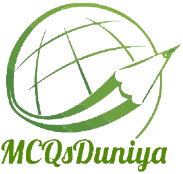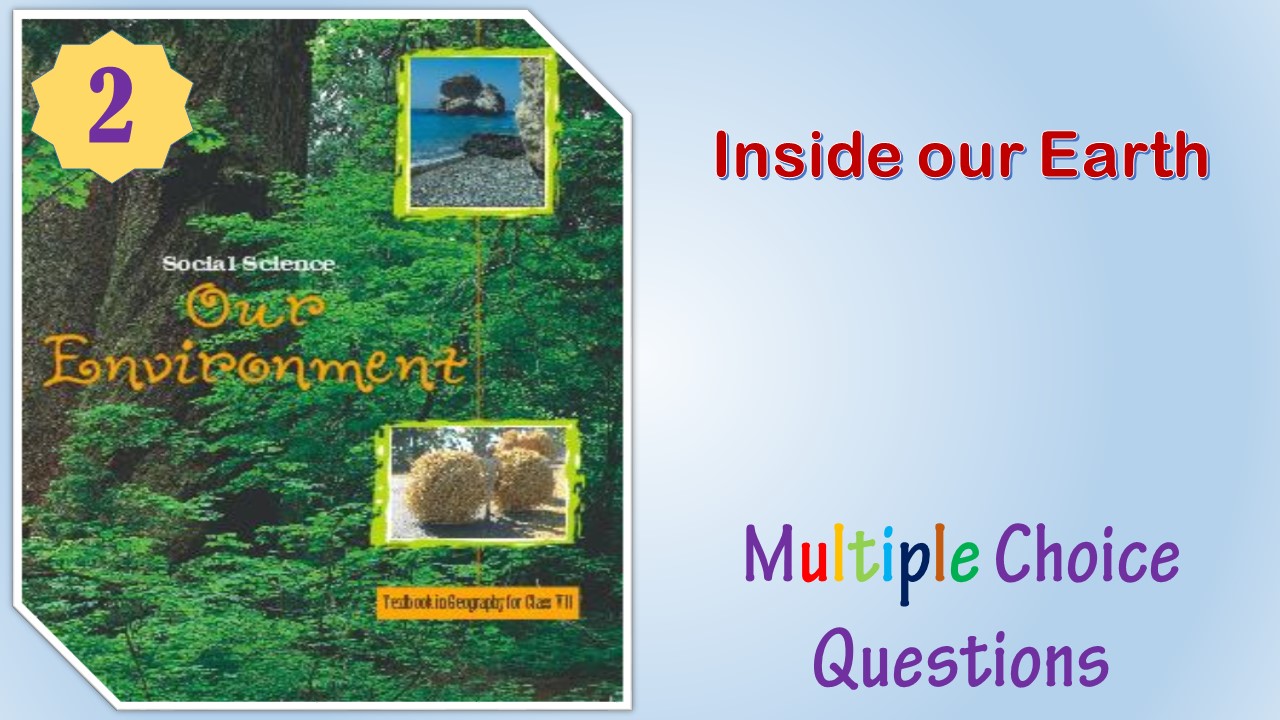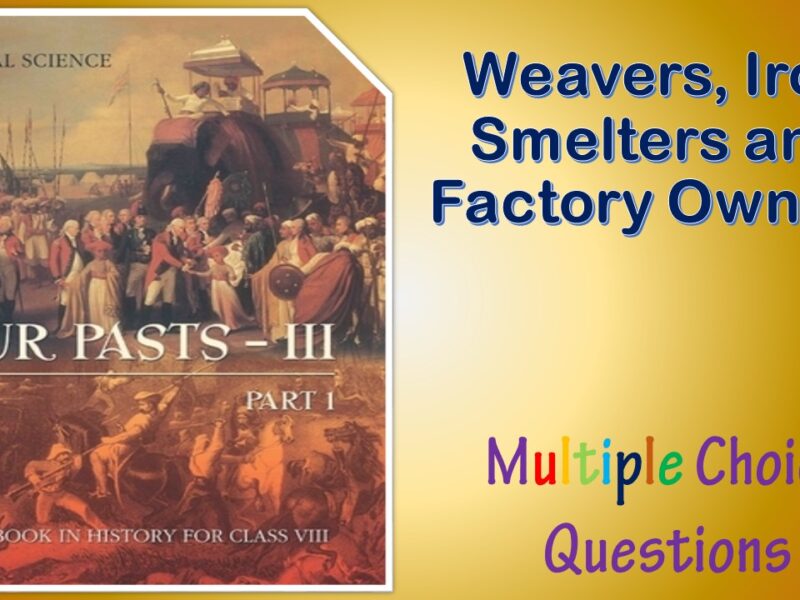Class 7 Social Science Geography MCQ Inside our Earth with Answers is Prepared Based on Latest Exam Pattern. Students can solve NCERT Class 7 Social Science Geography MCQ Inside our Earth with Answers to know their preparation level.
Students who are searching for NCERT Class 7 Social Science Geography MCQ Inside our Earth with Answers are compiled here to get good practice on all fundamentals. Know your preparation level on MCQ Questions for Class 7 Social Science Geography MCQ Inside our Earth with Answers. You can also verify your answers from the provided Class 7 Social Science Geography MCQ Inside our Earth with Answers. So, ace up your preparation with MCQ of Class 7 Social Science Geography MCQ & NCERT Textbook solutions Examinations.
CBSE Class 7 Social Science Geography MCQ
Inside our Earth
with Answers
Question : Which rock is the molten magma made up of?
(a) Igneous
(b) Metamorphic
(c) Sedimentary
(d) None of these
Answer : (a) IgneousShow Answer :
Question : What is the latin term of Igneous?
(a) Ignis
(b) Sedimentum
(c) Metamorphose
(d) None of these
Answer : (a) IgnisShow Answer :
Question : Gold, Petroleum and Coal are the examples of what?
(a) Rock
(b) Fossils
(c) Minerals
(d) Core
Answer : (b) FossilsShow Answer :
The remains of the dead plants and animals trapped in the layers of rocks are called fossils. Gold, Petroleum and Coal are the examples of these fossils.
Question : What is the Radius of the earth?
(a) 2600 km
(b) 3671km
(c) 7163 km
(d) 6371 km
Answer : (d) 6371 kmShow Answer :
The radius of the earth is 6371 km.
Question : What is the Innermost layer of the earth?
(a) Crust
(b) Mantle
(c) Core
(d) None of these
Answer : (c) CoreShow Answer :
The innermost layer is the core with a radius of about 3500 km. The central core has very high temperature and pressure.
Question : Rocks which contain fossils are called
(a) metamorphic rocks
(b) igneous rocks
(c) core
(d) sedimentary rocks
Answer : (d) sedimentary rocksShow Answer :
Question : Fossils are the remains of dead _
(a) Plants
(b) Animals
(c) Both a and b
(d) None of the above
Answer : CShow Answer :
Question : Any natural mass of mineral matter that makes up the earth’s crust is called a
(a) rock
(b) road
(c) sediment
(d) none of these
Answer : AShow Answer :
Question : Rocks which contain fossils are called
(a) metamorphic rocks
(b) igneous rocks
(c) core
(d) sedimentary rocks
Answer : DShow Answer :
Question : The depth of the deepest mine in South Africa is
(a) one km
(b) two km
(c) three km
(d) four km
Answer : DShow Answer :
Question : Where is the deepest mine in the world located?
(a) South America
(b) South Africa
(c) South India
(d) South Australia
Answer : BShow Answer :
Question : The Taj Mahal is made of
(a) White marble
(b) Black marble
(c) Red marble
(d) Yellow marble
Answer : AShow Answer :
Question : Sandstone is made from
(a) Grains of soil
(b) Grains of plants
(c) Grains of water
(d) Grains of sand
Answer : DShow Answer :
Question : The upper most layer of the earth’s surface is called
(a) the crustcorrect
(b) the brust
(c) the roads
(d) the forest
Answer : AShow Answer :
Question : The molten magma cools down deep inside the earth’s crust. Solid rocks so formed are called
(a) Intrusive Sedimentary rocks
(b) Intrusive Metamorphic rocks
(c) Extrusive igneous rocks
(d) Intrusive igneous rocks
Answer : DShow Answer :
Question : What is the percentage of the volume of the earth?
(a) 1
(b) 15
(c) 89
(d) 20
Answer : AShow Answer :
Question : What is meaning of igneous?
(a) Air
(b) Water
(c) Lime
(d) Fire
Answer : DShow Answer :
Question : Igneous and sedimentary rocks can change into:
(a) Intrusive igneous rocks
(b) Extrusive igneous rocks
(c) Metamorphic rocks
(d) Igneous rocks
Answer : CShow Answer :
Question : What are the layers of the earth?
(a) Crust
(b) Mantle
(c) Core
(d) All of the above
Answer : DShow Answer :
Question : Which rocks are known as primary rocks?
(a) Igneous rocks
(b) Sedimentary rocks
(c) Metamorphic rocks
(d) None of these
Answer : AShow Answer :
Question : When magma from deep below forces its way up to earths surface, it is called
(a) Sand
(b) Marble
(c) Sediments
(d) Volcano
Answer : DShow Answer :
Question : The lightest of the materials are concentrated in this layer
(a) Crust
(b) Mantle
(c) Inner Core
(d) Outer Core
Answer : AShow Answer :
Question : The molten magma cools down deep inside the earth’s crust. Solid rocks so formed are called
(a) Intrusive Sedimentary rocks
(b) Intrusive Metamorphic rocks
(c) Extrusive igneous rocks
(d) Intrusive igneous rocks
Answer : DShow Answer :
Question : ______ minerals are found in the continental masses
(a) Silica and alumina
(b) Siica and magnesium
(c) Nickel and iron
(d) Silica and iron
Answer : AShow Answer :
Question : There are three major types of rocks except
(a) Metamorphic rocks
(b) Sedimentary rocks
(c) Igneous rocks
(d) Mantle rocks
Answer : DShow Answer :
Question : What is the name of the rock which contains fossils?
(a) Seimentary rocks
(b) Metamorphic rocks
(c) Igneous rocks
(d) Core
Answer : AShow Answer :
Question : The remains of the dead plants and animals trapped in the layers of rocks are called
(a) Rocks
(b) Conventional
(c) Fossils
(d) Minerals
Answer : CShow Answer :
Question :The Deccan plateau is made up of:
(a) Clay
(b) Granite
(c) Basalt
(d) None of the above
Answer : (c) BasaltShow Answer :
Question : The depth of deepest mine in South Africa is about:
(a) 3km
(b) 4km
(c) 5 km
(d) 6 km
Answer : (b) 4kmShow Answer :
Question : The innermost layer is the core is made of:
(a) Nickel and Iron
(b) Silica and Alumina
(c) Silica and magnesium
(d) a and b both
Answer : (a) Nickel and IronShow Answer :
Question : The common mineral in the continental masses and the oceanic crust is _____
(a) Silicon
(b) Magnesium
(c) Aluminium
(d) Iron
Answer : AShow Answer :
Question : The main mineral constituents of the continental mass are
(a) Silica and alcohol
(b) Silver and alcohol
(c) Silver and alumina
(d) Silica and alumina
Answer : DShow Answer :
Question : Depth of mantle layer of the earth is:
(a) 2900 km
(b) 3000 km
(c) 3100km
(d) 3200 km
Answer : (a) 2900 kmShow Answer :
Question : In search for oil engineers have dug a hole about:
(a) 3km
(b) 4km
(c) 5 km
(d) 6 km
Answer : (d) 6 kmShow Answer :
Question : Which layer is having a radius of about 3500 km?
(a) Sial
(b) Crust
(c) Core
(d) Mantle
Answer : CShow Answer :
Question : Igneous rocks are called primary rocks because:
(а) All the other rocks are formed from the igneous rocks.
(b) These are important for human beings.
(c) These rocks produce all the ailments.
(d) None of the above.
Answer : AShow Answer :
Question : What happens when igneous and sedimentary rocks go under heat and pressure
(a) They change into graphite
(b) They change into fossils
(c) They change into metamorphic rocks
(d) They change into minerals
Answer : CShow Answer :
Question : Rocks roll down, crack, and hit each other and are broken down into small fragments. These smaller particles are called
(a) Sediments
(b) Sand
(c) Piece
(d) Units
Answer : AShow Answer :
Question : What is meaning of igneous?
(a) Air
(b) Water
(c) Lime
(d) Fire
Answer : (d) FireShow Answer :
Question : The radius of the earth is:
(a) 6000 km
(b) 6300 km
(c) 6371 km
(d) 6400 km
Answer : (c) 6371 kmShow Answer :
Question : Depth of mantle layer of the earth is:
(a) 2900 km
(b) 3000 km
(c) 3100km
(d) 3200 km
Answer : AShow Answer :
Question : In search for oil engineers have dug a hole about:
(a) 3 km
(b) 4 km
(c) 5 km
(d) 6 km
Answer : DShow Answer :
Question : Thinnest layer of the earth is
(a) Crust
(b) Nife
(c) Core
(d) Mantle
Answer : AShow Answer :
Question : Igneous and sedimentary rocks can change into:
(a) Intrusive igneous rocks
(b) Extrusive igneous rocks
(c) Metamorphic rocks
(d) Igneous rocks
Answer : (c) Metamorphic rocksShow Answer :
Question : Igneous rocks are made when:
(a) The solid magma melts and it becomes solid
(b) The cool magma molten, it becomes solid
(c) The molten magma cools, it becomes solid
(d) Solid magma molten, it becomes solid
Answer : (c) The molten magma cools, it becomes solidShow Answer :
Question : Igneous rocks are called primary rocks because:
(a) All the other rocks are formed from the igneous rocks.
(b) These are important for human beings.
(c) These rocks produce all the ailments.
(d) None of the above.
Answer : (а) All the other rocks are formed from the igneous rocks.Show Answer :
Question : Which rocks are known as primary rocks?
(a) Igneous rocks
(b) Sedimentary rocks
(c) Metamorphic rocks
(d) None of these
Answer : (a) Igneous rocksShow Answer :
When the molten magma cools, it becomes soli(d) Rocks thus formed are called igneous rocks. They are also called primary rocks.
Question : Where is the deepest mine in the world located?
(a) South America
(b) South Africa
(c) South Australia
(d) South India
Answer : (b) South AfricaShow Answer :
The deepest mine in the world, is in South Afric(a) It is about 4 km. deep. In search for oil engineers have dug a hole about 6 km. deep.
Question : What is the percentage of the volume of the earth?
(a) 1
(b) 15
(c) 89
(d) 20
Answer : (a) 1Show Answer :
The crust forms only 1 per cent of the volume of the earth, 84 per cent consists of the mantle and 15 per cent makes the core.
Question : What are the layers of the earth?
(a) Crust
(b) Mantle
(c) Core
(d) All of the above
Answer : (d) All of the aboveShow Answer :
Three layers of the earth are crust, mantle and core.
Question :Where is the deepest mine in the world located?
(a) South America
(b) South Africa
(c) South India
(d) South Australia
Answer : (b) South AfricaShow Answer :
Question : The depth of the deepest mine in South Africa is
(a) one km
(b) two km
(c) three km
(d) four km
Answer : (d) four kmShow Answer :
Question : What are the uses of rocks?
(a) Building materials
(b) As a source of metals
(c) Both a and b
(d) None of these
Answer : (c) Both a and bShow Answer :
Rocks are useful in many ways as building materials and as a source of metals like iron, copper et(c) and fossil fuels. They also yield valuable gems such as diamonds, garnet, jade et(c)
Question : Why earth is called a dynamic planet?
(a) Continuously undergoes changes
(b) Never change
(c) Is very large in size
(d) None of these
Answer : (a) Continuously undergoes changesShow Answer :
Earth is called a dynamic planet because it continuously undergoes changes inside and outside.
Question : What is a rock?
(a) Natural mass of mineral
(b) Artificial mass
(c) Both a and b
(d) None of these
Answer : (a) Natural mass of mineralShow Answer :
A rock is a natural mass of mineral matter that makes up the earth’s crust.
Question : The upper most layer of the earth’s surface is called
(a) the crust
(b) the brust
(c) the roads
(d) the forest
Answer : (a) the crustShow Answer :
Question : What is the radius of the earth?
(a) 3671 km
(b) 7163 km
(c) 6371 km
(d) 1736 km
Answer : (c) 6371 kmShow Answer :
Question : Any natural mass of mineral matter that makes up the earth’s crust is called a
(a) rock
(b) road
(c) sediment
(d) none of these
Answer : (a) rockShow Answer :
Question : The sediments are transported and deposited by
(a) wind
(b) water
(c) wind and water
(d) none of these
Answer : (c) wind and waterShow Answer :
Question : The process of transformation of the rock from one form to another is known as
(a) road cycle
(b) food cycle
(c) rock cycle
(d) all of these
Answer : (c) rock cycleShow Answer :
Fill in the blanks
Question : Lava is the molten magma from ……….. of the earth’s surface.
Answer : interiorShow Answer :
Question : Like a …………. the earth is made up of …………. layers.
Answer : onion, concentricShow Answer :
Question : Crust is about ………….. km on the continental mass and ………….. km on the ocean floor.
Answer : 35 and 5Show Answer :
Question : The mantle makes up _______ % of the Earth by volume.
Answer : 57%Show Answer :
Question : Core has a radius of about ………….. km and has very high temperature and ………..
Answer : 3500, pressureShow Answer :
Question : Limestone under excessive heat and pressure changes into ………….
Answer : marbleShow Answer :
Question : Gold, petroleum and coal are examples of ……………. .
Answer : mineralsShow Answer :
Question : The Crust layer of the earth is ……………. .
Answer : thinnest layerShow Answer :
Question : Red Fort is made of red ……………. .
Answer : sandstoneShow Answer :
Question : The Taj Mahal is made of white ……………. .
Answer : marbleShow Answer :
Question : The remains of the dead plants and animals trapped in the layers of rocks are called ……………. .
Answer : fossilsShow Answer :
Question : The crust forms only ……………. % of the volume of the earth.
Answer : 0.5Show Answer :
Question : The deepest mine in the world is in the ……………. .
Answer : South AfricaShow Answer :
Question : The main mineral constituents of the continental mass are ……………. and ……………. .
Answer : silica and aluminaShow Answer :
Question : The innermost layer is the core with a radius of about ……………. km.
Answer : 3500Show Answer :
Question : Igneous rocks also called ……………. .
Answer : primary rocks.Show Answer :
Write whether the given statements are true or false:
Question : Crust is the thickest of all the layers.
Answer : FalseShow Answer :
Question : Core is the innermost layer of the earth.
Answer : TrueShow Answer :
Question : Mantle extends up to the depth of 2900 km.
Answer : TrueShow Answer :
Question : The loose sediments are hardened to form metamorphic rocks.
Answer : FalseShow Answer :
Question : Deccan plateau is made up of basalt.
Answer : TrueShow Answer :
Question : Fossils are remains of dead plants and animals.
Answer : TrueShow Answer :




